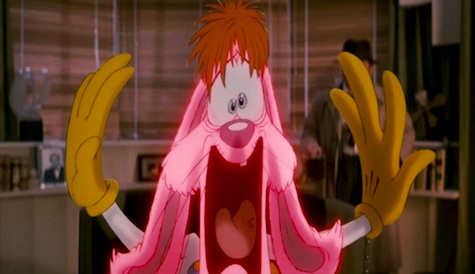Who Framed Roger Rabbit is one of those films that is great for both kids and adults. For the children, the premise is about cartoon characters who live in the real world, which is basically every playground dream ever come to life. It also combines both Disney and Warner Brothers characters in one film, a glorious crossover that audiences had never seen before and are unlikely to see again. (The rights issues were a nightmare.) For the adults, the words of Eddie Valiant say it best: the tale is primarily one of greed, sex, and murder. It’s film noir fun for the whole family!
This was one of my favorite movies as a child, but I have to admit, if you stop for even a moment to consider the reality of the world these characters occupy… it is deeply screwed up.
So let’s start by talking about the toons. Where did they come from in the first place? It seems oddly safe to assume that humans are still responsible for creating them, particularly when we consider Jessica Rabbit’s famous line: “I’m not bad, I’m just drawn that way.” It could be a figure of speech, sure, but it’s more likely that toons are first “drafted” into existence by people and then get lives of their own. In that case, animation is a very different job in this universe. You’re more like a mad scientist, creating a new creature and releasing it unto the world.
And what are the toons created for, exactly? Why, to entertain us, of course!
Wait, what?
As far as we see, toons who make bank do so by starring in cartoons. That’s it. That’s the one way that you do well as a toon in our world. The ones who don’t work much in entertainment likely pay the bills by taking positions in Toon Town, doing jobs that you would normally find in the non-animated world as well—postal workers, vocal coaches, bankers and the like. They don’t get to take those jobs outside of Toon Town, however. They work within clearly defined parameters set up by flesh and blood people because we don’t want them taking human jobs and working in human businesses.
Can you see me waving to the uncomfortable allegory as it waltzes by?
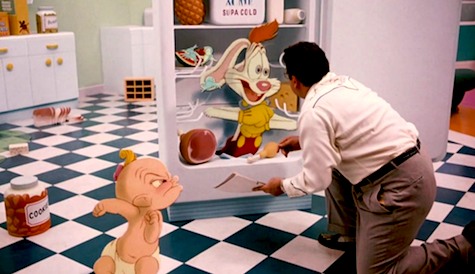
It gets worse: Eddie first sees Roger’s wife Jessica working at a place called The Ink and Paint Club. It’s a revue venue where toons can perform, but only humans are allowed in as patrons. It’s also a pretty handy stand-in for places like the Cotton Club in Harlem, New York where some of the greatest black jazz players performed for a whites-only audience. The toons are allowed to work the floor at the Ink and Paint as well (even poor Betty Boop has a gig as a cigarette vendor there now that her work has dried up), but certainly not to sit down and watch the show.
If you need further proof of their sub-human status, you need only look at how they are treated by their creative peers. In the opening of the film, when Roger can’t produce the correct reaction to having a refrigerator dropped on his head, he begs the director to try the take again, claiming he can handle it. The director’s response? “I’m not worried about you, I’m worried about the refrigerator!” Yes, Roger is incapable of being permanently injured by the fridge, but it’s hard to believe that there are no traumatic effects involved with consistent abuse, even if they are psychological rather than physical.
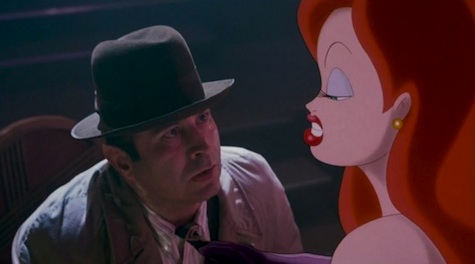
Roger’s wife, Jessica, is another perfect microcosm of exactly what’s wrong with their society. Without the ability to change due to the way she is “drawn,” Jessica is incapable of altering the way people perceive her. She’s a femme fatale, made to be sensual and enticing, but that’s only how she appears; it tells us nothing about who she is. She is an exacting metaphor for how women are constantly judged at face value. The fact that she is smart and capable and appreciates humor—she married Roger because he makes her laugh—is irrelevant because the way she looks determines what everyone assumes of her. She is used precisely for her sex appeal at the beginning of the film, in a game of blackmail between R.K. Maroon and Marvin Acme. Then she spends the rest of the film trying to protect her husband, but when she comes to Eddie with her story about what happened, he initially doesn’t believe her. Why? Because she doesn’t exactly look the part of loving, devoted wife.
(Aside question: Is Roger and Jessica’s marriage as a rabbit and a woman an interspecies one if they’re both toons? I can’t quite decide there….)
Are toons pre-programmed to their detriment in this world? When Judge Doom is trying to find Roger in Delores’ bar, he manages it by tapping out the rhythm to the first half of “Shave and A Haircut.” Roger is physically incapable of leaving the call unanswered and promptly gives himself up. It’s meant to be hilarious—and of course it is—but not having the free will to stay silent when your life is in danger isn’t exactly chuckle-worthy. What about their predicament with the handcuffs? It plays as though Roger pretends he can’t slip them so that he can get Eddie to stick by him, but when Eddie asks as much, Roger’s response is that he could only get out of them “when it was funny!” And for all we know, that might truly be the case.
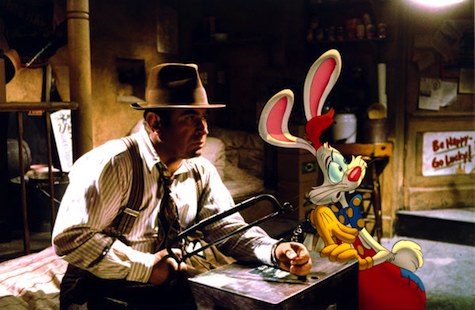
Similar questions are raised when Eddie gets Roger to drink alcohol, prompting the attack that allows them to escape their first joint encounter with Doom. Roger already knows what alcohol does to him (we see its effects earlier in the film) and doesn’t want the shot. The way that Eddie gets him to gulp it down is by employing the old “reverse the back-and-forth argument” trick. Roger gamely switches along with him, then takes the drink. So the question returns: Is that cue built into Roger’s being by virtue of being a toon? Are all toons required to respond the same way to those arguments, and how terribly can they be taken advantage of if that’s the case?
The alcohol itself poses an interesting question; Roger’s response to human liquor is straight out of a cartoon—he effectively goes nuclear, steaming and shrilling like an alarm. Does the rabbit have an allergy to human alcohol, or is he made to respond to real world environments as though he’s still in a cartoon? And what purpose could that possibly serve practically, except to make toons consistently amusing even when they’re off the clock? It only helps Roger by accident, after all. And as he says to Eddie halfway through the film, “My whole purpose in life is to make people laugh.” Because it literally is.
There’s Eddie’s initial hatred of toons to contend with at the start of the film, which is prompted by the death of his brother at the hands of the Judge years ago. While we can sympathize with Valiant’s pain, the fact that he proceeds to view all toons as despicable smacks of “someone who drove a Mitsubishi hit my dog with their car and now I hate all people who drive Mitsubishis.” Or, obviously, of far more serious types of prejudice that human beings have to suffer through every day.
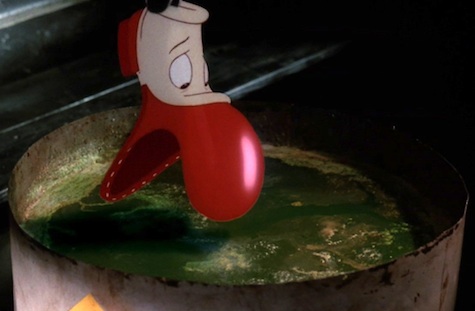
But the place where things get truly unsettling unfolds when Judge Doom is put under the microscope. Doom introduces himself under the guise of a human judge who has made it his responsibility to bring toons to justice, and he appoints himself as the law in its entirety where they are concerned. As far as we see, the judge has been given dispensation to handle toons however he sees fit; with the creation of Dip, that means he is allowed to murder them without due process, for any reason he deems reasonable. (As when he dips a lone cartoon shoe for no reason other than to prove the deadly liquid’s power.)
Some people in the film seem uncomfortable at Doom’s methods, but they never lift a hand to stop him. Also take into account that no one is regulating the production of Dip but him, which is essentially like allowing a private contractor to develop a chemical weapon in secret and then use it on a portion of the population indiscriminately. No one takes a careful look into what Doom is doing—no sneaky reporters, no crafty cops, no lawyers for toon rights. No one but Eddie, and he’s a damn hard sell to begin with. Not to mention that he only gets involved because he was initially hired to prove Roger had killed a human. Toon justice isn’t on anyone’s radar, and we can’t be sure if it’s because people are a-okay with how they’re treated, or just happy to stay uninformed. Probably a mix of both.
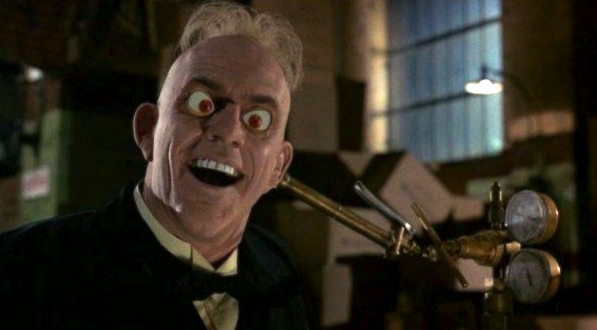
And what about Doom’s true identity as a toon himself? We have no clue what made him fly the cuckoo’s nest, going to such incredible lengths to serve a vision and obliterate Toon Town. You could flag him as flat out crazy and not assign any motive, but he sort of demands it. He’s a toon who prefers to disguise himself as a human and figures out the only way to kill other toons. The freeway plan is a nice, weirdo excuse that plays into humanity’s fear of industrialization and modernization, but that’s not what he’s really after—he’s created a reason to dip every single one of them. To commit genocide on his own kind. And what would make him want to do that? Could it have something to do with the reasons why he prefers to wear a mask that allows him to pass for one of us?
The picture all this paints is horrifying, a world where sentient beings are treated as non-persons, their lives worthless beyond their ability to humor us. With that in mind, the end of the film is more than just a relief for Roger and Jessica—not only are the lives of all toons spared, but Acme’s will makes certain that they will have far more control over their future now that Toon Town belongs to them. Still, it doesn’t ensure their protection from murder, or a fair shake when they’re accused of one themselves. That job is apparently still Eddie Valiant’s purview, and it’s a good thing that he managed to put his brother’s death behind him because they’re in dire need of his help.
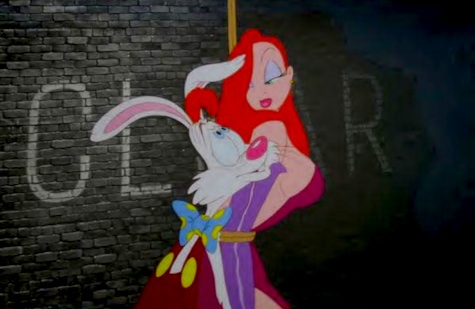
Which is not to say that this should be on everyone’s mind whenever they watch Who Framed Roger Rabbit at all. Merely that picking apart that colorful place offers a lot more blam-pow for your buck if you decide to take it seriously. Because Roger’s right—sometimes in life, laughter is the only weapon we have. And by delivering those laughs, the film bearing his name can help ward us against what’s really going on in Toon Town.
Emmet Asher-Perrin still can’t handle that shoe getting dipped—mainly because its pair is still out there somewhere all alone. She was recently on the Geeks Guide to the Galaxy podcast talking about Star Trek Into Darkness, and an essay of hers can be found in the newly released Queers Dig Time Lords. You can bug her on Twitter and read more of her work here and elsewhere.










